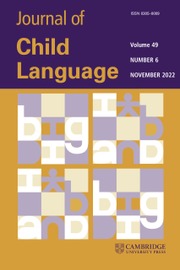Article contents
Representations of abstract grammatical feature agreement in young children*
Published online by Cambridge University Press: 30 January 2015
Abstract
A fundamental question in language acquisition research is whether young children have abstract grammatical representations. We tested this question experimentally. French-learning 30-month-olds were first taught novel word–object pairs in the context of a gender-marked determiner (e.g., unMASCravole ‘a ravole’). Test trials presented the objects side-by-side while one of them was named in new phrases containing other determiners and an adjective (e.g., leMASCjoli ravoleMASC ‘the pretty ravole’). The gender agreement between the new determiner and the non-adjacent noun was manipulated in different test trials (e.g., leMASC__ravoleMASC; *laFEM__ravoleMASC). We found that online comprehension of the named target was facilitated in gender-matched trials but impeded in gender-mismatched trials. That is, children assigned the determiner genders to the novel nouns during word learning. They then processed the non-adjacent gender agreement between the two categories (Det, Noun) during test. The results demonstrate abstract featural representation and grammatical productivity in young children.
Information
- Type
- Articles
- Information
- Copyright
- Copyright © Cambridge University Press 2015
Footnotes
This research was supported by NSERC, SSHRC, and CFI grants to the second author. We thank all the families who participated. We also thank Mireille Babineau, Julie Raymond, and Camille Bédard for research assistance. We are grateful to André Achim for his helpful suggestions during this study.
References
REFERENCES
- 16
- Cited by


